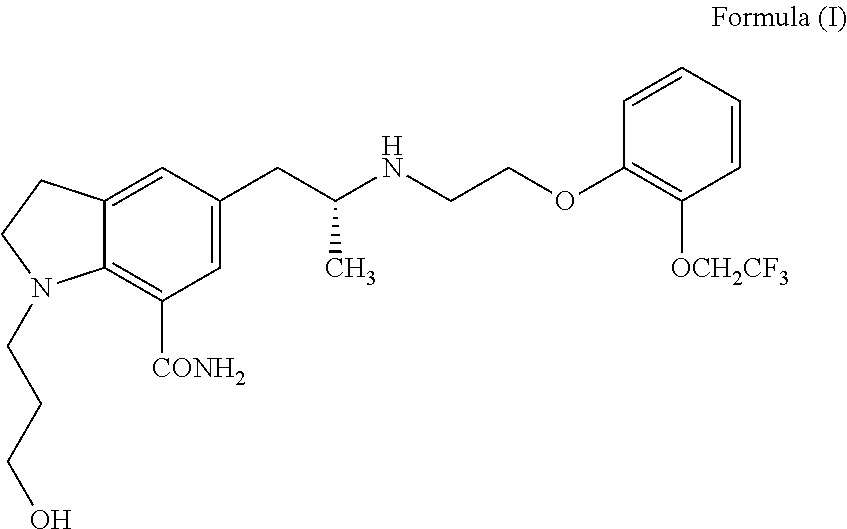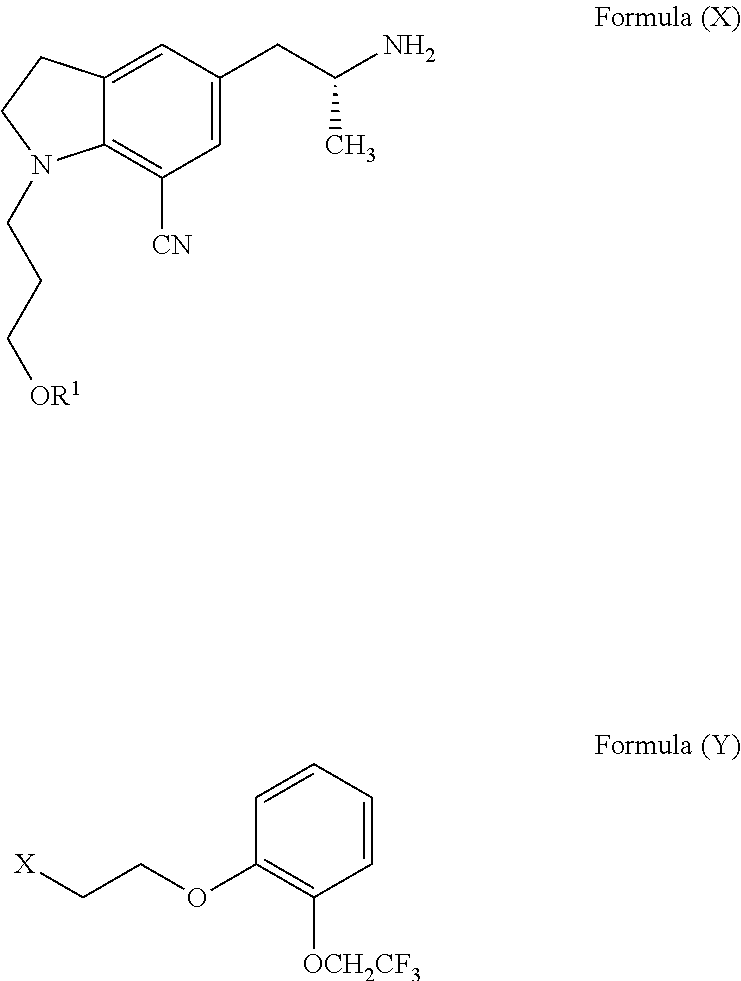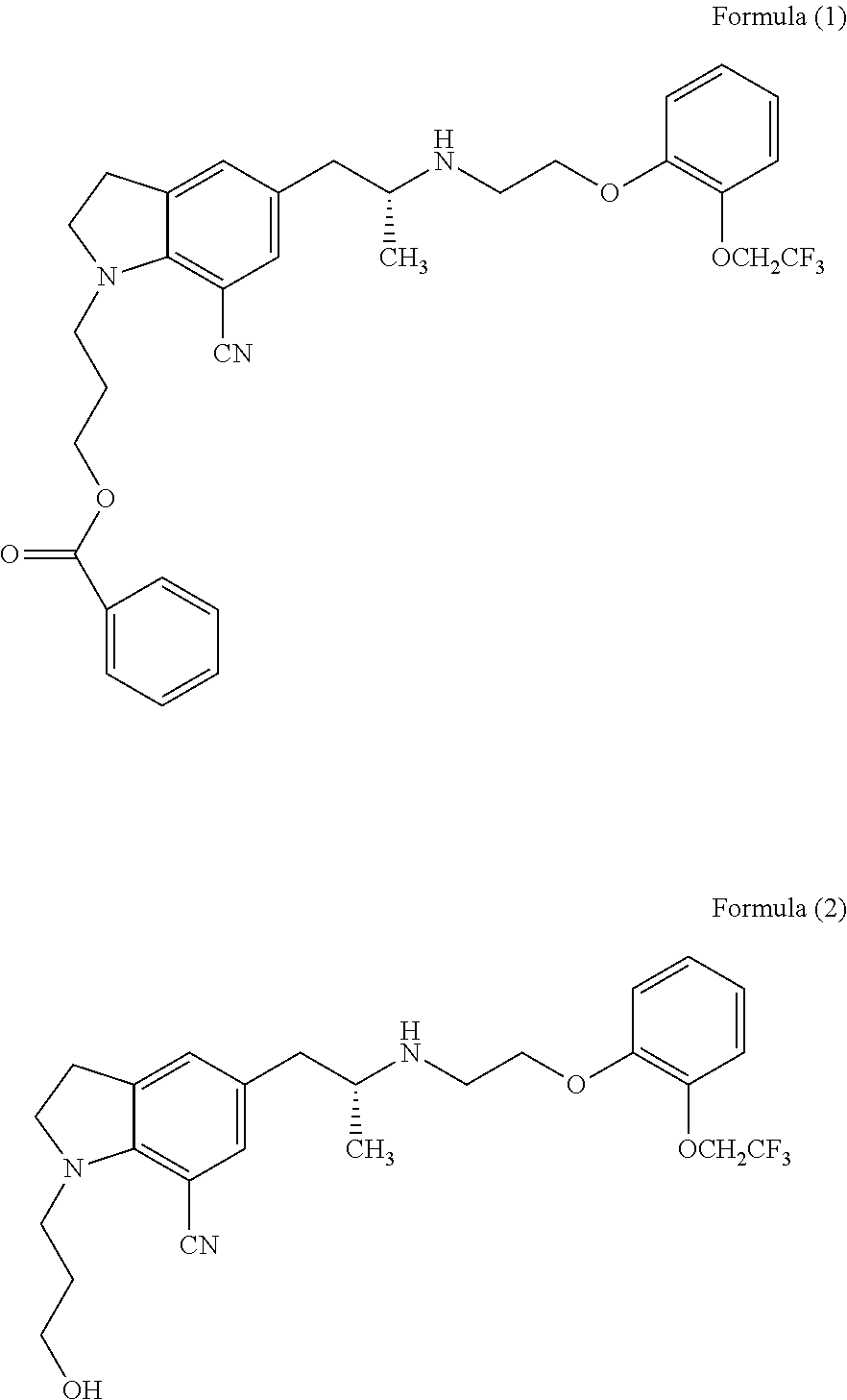Process for the preparation of indoline derivatives and their intermediates thereof
a technology of indoline derivatives and intermediates, applied in the field of compound preparation, can solve the problem of low yield of desired compound
- Summary
- Abstract
- Description
- Claims
- Application Information
AI Technical Summary
Benefits of technology
Problems solved by technology
Method used
Image
Examples
reference example 1
Preparation of 1-[3-(t-Butyl-dimethyl-silanyloxy)-propyl]-2,3-dihydro-1H-indole-7-carbonitrile (II)
[0232]A mixture of 7-Cyano indoline (5 g, 0.035 mole), dimethyl formamide (50 ml) and powdered K2CO3 (9.6 g, 0.07 mole) was heated to 70° C. and Toluene-4-sulfonic acid-3-(t-butyl dimethyl)-silanyloxypropyl ester (12.7 g 0.037 mole) was added to reaction mixture. Reaction mixture was quenched in distilled water and product extracted in ethyl acetate and extract washed with saturated brine solution, dried over anhydrous sodium sulphate. The solvent was evaporated under reduced pressure to give 10 g of (II) as oil.
reference example 2
Preparation of R—(N-Ethoxy carbonyl) alanine (III)
[0233]R-Alanine (4.45 g, 0.05 moles) was dissolved in 50 ml 1 N sodium hydroxide solution and cooled to 15° C. Ethyl chloroformate (5 ml, 0.05 mole) was added while maintaining the pH of reaction mixture at 9-9.5 by using 1N sodium hydroxide solution. Reaction mixture was cooled to 0-5° C. and extracted with diethyl ether. Orthophosphoric acid was added to aqueous layer and pH was adjusted below 1.0. Product was extracted in dichloromethane. Organic layer was dried over sodium sulphate. The solvent was evaporated under reduced to give 6.5 g of R—(N-Ethoxy carbonyl)alanine as oil.
example-1
Preparation of (2-{1-[3-(tert-Butyl-dimethyl-silanyloxy)-propyl]-7-cyano-2,3-dihydro-1H-indol-5-yl}-1-methyl-2-oxo-ethyl)-carbamic acid ethyl ester, (IV)
[0234]To the solution of R—(N-Ethoxy carbonyl)alanine (III) (16.1 g, 0.1 moles) in dry dichloromethane (300 ml) at 0° C. under inert atmosphere was added 0.5 ml DMF and oxalyl chloride (10 ml, 0.0105 mole). Reaction mixture was allowed to warm to room temperature with stirring and after 2 hours it was cooled to −15° C. Then AlCl3 (28.4 g, 0.21 mole) was added in one portion. To the reaction mixture a solution of 1-[3-(tert-Butyl-dimethyl-silanyloxy)-propyl]-2,3-dihydro-1H-indole-7-carbonitrile (II) (31.65 g, 0.1 mole) in 150 ml dichloromethane was added at −15. Reaction mixture was quenched with 150 ml of cold water and 50 ml of 1N HCl. Organic layer was washed with saturated brine solution and dried over anhydrous sodium sulphate. The solvent was evaporated under reduced to give 30 g of compound (IV) as oil.
PUM
| Property | Measurement | Unit |
|---|---|---|
| temperature | aaaaa | aaaaa |
| temperature | aaaaa | aaaaa |
| temperature | aaaaa | aaaaa |
Abstract
Description
Claims
Application Information
 Login to View More
Login to View More - R&D
- Intellectual Property
- Life Sciences
- Materials
- Tech Scout
- Unparalleled Data Quality
- Higher Quality Content
- 60% Fewer Hallucinations
Browse by: Latest US Patents, China's latest patents, Technical Efficacy Thesaurus, Application Domain, Technology Topic, Popular Technical Reports.
© 2025 PatSnap. All rights reserved.Legal|Privacy policy|Modern Slavery Act Transparency Statement|Sitemap|About US| Contact US: help@patsnap.com



